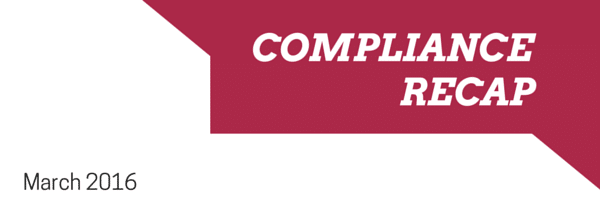The government was busy during the month of March, issuing the massive Benefit Payment and Parameters rule in addition to numerous other updates. The IRS has added filing errors relating to Form 5500 to its project list, and multiple federal agencies confirmed that the just-announced templates relating to the Summary of Benefits and Coverage will not go into effect until the first day of the first plan year beginning on or after April 1, 2017.
The Department of Health and Human Services’ (HHS) Office for Civil Rights (OCR) has begun its next phase of HIPAA audits for covered entities and business associates. Phase 2 is intended to enhance industry awareness of compliance obligations in relation to HIPAA’s Privacy, Security, and Breach Notification Rules.
The Centers for Medicare & Medicaid Services (CMS) has also decided to extend the transition policy that allows insurers in the individual and small group markets to renew policies that would otherwise have to be cancelled because they do not comply with the Patient Protection and Affordable Care Act (ACA) market reforms. In states that permit renewal, policies that have been continuously renewed since January 1, 2014, may renew coverage for policy years beginning on or before October 1, 2017. This date was previously October 1, 2016. Policies renewed under this transition relief will not be out of compliance with the market reforms. The policies cannot extend past December 31, 2017.
UBA Guides
UBA released two new guides to assist applicable large employers with IRS reporting obligations under the ACA:
Benefit Payment and Parameters
The 2017 Benefit and Payment Parameters (BPP) rule, an annual rule that sets policies relating to the Patient Protection and Affordable Care Act (ACA), has been released by the Centers for Medicare and Medicaid Services (CMS). The 2017 rule contains numerous updates, including the annual open enrollment periods for the individual market, rating areas for small group health plans, guaranteed availability and renewability, broker and agent registration to assist consumers with applying for Exchange coverage, the employer notice system when its employees are determined to be eligible for a tax credit, and exemptions to the individual mandate. The rule also set cost sharing limits for 2017.
In conjunction with the rule, the Department of Health and Human Services (HHS) released an FAQ on the implementation of the 2017 moratorium on the Health Insurance Provider (HIP) fee. The FAQ states that insurers will not be charged the HIP fee for the 2017 fee year, based on 2016 information. Insurers should adjust premiums downward as a result.
Finally, HHS also released a bulletin that extends transitional plans from expiring on October 1, 2017, to the end of 2017 to allow individuals to enroll in an ACA-compliant plan beginning in calendar year 2018, rather than having to account for October through December 2017 prior to the new calendar year.
The rule set the 2017 maximum annual limitation on cost sharing at $7,150 for self-only coverage and $14,300 for other than self-only coverage.
Read about the Benefit Payment and Parameters rule.
Question of the Month
- What federal guidance prohibits employers from reimbursing individual health insurance policies?
- The IRS has issued extensive guidance prohibiting employers from reimbursing health insurance policies on an individual basis. It issued two notices in 2015 that addressed this issue.
In February 2015, the IRS provided greater detail on the issue when it issued Notice 2015-17, which addresses employer payment or reimbursement of individual premiums in light of the requirements of the ACA. For many years, employers were permitted to reimburse premiums paid for individual coverage on a tax-favored basis, and many smaller employers adopted this type of an arrangement instead of sponsoring a group health plan. However, these “employer payment plans” frequently are unable to meet all of the PPACA requirements that took effect in 2014, and in a series of Notices and frequently asked questions (FAQs) the IRS has made it clear that an employer may not either directly pay premiums for individual policies or reimburse employees for individual premiums on either an after-tax or pre-tax basis. This is the case whether payment or reimbursement is done through a health reimbursement arrangement (HRA), a Section 125 plan, a Section 105 plan, or another mechanism.
The notice reiterates this position. It also clearly states that an employer may increase an employee’s taxable wages to help cover the cost of health coverage if it chooses not to offer coverage, but the employer may not require an employee to purchase health insurance or certify that he or she has coverage in order to receive the bonus or other wage increase. If the bonus or increase is specifically designated as a premium reimbursement or it must be used for premiums, this would be an impermissible employer payment plan.
Under these rules, if the employer reimburses or directly pays premiums for individual coverage, on either a pre-tax or after-tax basis, it has created a noncompliant group health plan and the $100 per day per employee penalty would apply. Reimbursement and payment of group health premiums is still allowed.
Most recently, in December 2015, in Notice 2015-87 the IRS restated that employer arrangements that reimburse the cost of individual market coverage under a cafeteria plan will not be integrated with the individual market coverage and that these arrangements will be unable to comply with the ACA’s annual dollar limit prohibitions or the preventive service requirements and will fail to satisfy market reforms. Practically speaking, these arrangements are prohibited regardless of how they are structured.
The prior guidance on employer payment plans can be found here: January 2013, September 2013, November 2014, and December 2014.












